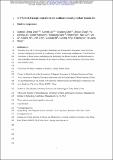A VTA GABAergic Neural Circuit Mediates Visually Evoked Innate Defensive Responses
Author(s)
Zhou, Zheng; Liu, Xuemei; Chen, Shanping; Zhang, Zhijian; Liu, Yuanming; Montardy, Quentin; Tang, Yongqiang; Wei, Pengfei; Liu, Nan; Li, Lei; Song, Ru; Lai, Juan; He, Xiaobin; Chen, Chen; Bi, Guoqiang; Feng, Guoping; Xu, Fuqiang; Wang, Liping; ... Show more Show less
DownloadSubmitted version (4.047Mb)
Publisher with Creative Commons License
Publisher with Creative Commons License
Creative Commons Attribution
Terms of use
Metadata
Show full item recordAbstract
Innate defensive responses are essential for animal survival and are conserved across species. The ventral tegmental area (VTA) plays important roles in learned appetitive and aversive behaviors, but whether it plays a role in mediating or modulating innate defensive responses is currently unknown. We report that VTAGABA+ neurons respond to a looming stimulus. Inhibition of VTAGABA+ neurons reduced looming-evoked defensive flight behavior, and photoactivation of these neurons resulted in defense-like flight behavior. Using viral tracing and electrophysiological recordings, we show that VTAGABA+ neurons receive direct excitatory inputs from the superior colliculus (SC). Furthermore, we show that glutamatergic SC-VTA projections synapse onto VTAGABA+ neurons that project to the central nucleus of the amygdala (CeA) and that the CeA is involved in mediating the defensive behavior. Our findings demonstrate that aerial threat-related visual information is relayed to VTAGABA+ neurons mediating innate behavioral responses, suggesting a more general role of the VTA. Keywords: Ventral tegmental area; GABAergic neurons; innate fear; superior collic-55ulus; looming; defensive responses.
Date issued
2019-06Department
McGovern Institute for Brain Research at MITJournal
Neuron
Publisher
Elsevier BV
Citation
Zhou, Zheng et al., "A VTA GABAergic Neural Circuit Mediates Visually Evoked Innate Defensive Responses." Neuron 103, 3 (August 2019): P473-488.e6 © 2019 Elsevier Inc.
Version: Original manuscript
ISSN
0896-6273